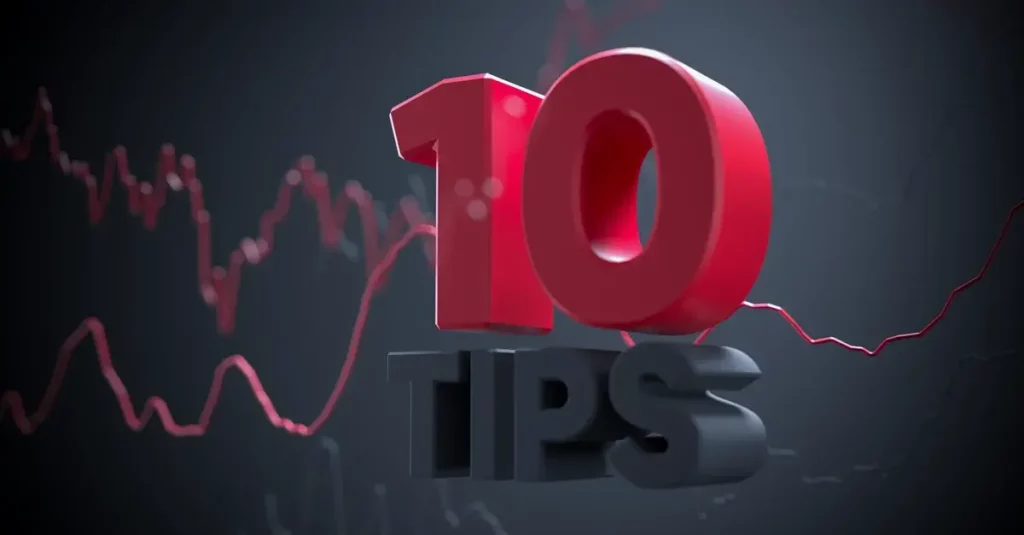
Forex Trading: 10 Tips That Actually Work
Contents
Forex trading is an advantageous field for financial development given its great liquidity and ongoing market presence. But effectively managing the currency markets calls for strategic planning and rigorous execution, not just knowledge of the fundamentals. This article is meant to provide useful and practical guidance meant to greatly improve your Forex trading efficiency and final results. From risk management to psychological preparedness, these tips provide both novice and experienced traders with tools for smart and effective trading.
The List of 10 Essential Forex Trading Tips
- Embrace Risk Management
- Stay Informed About Market Movements
- Develop a Consistent Trading Strategy
- Master Market Analysis Techniques
- Focus on a Specific Market Segment
- Understand and Use Leverage Wisely
- Practice on a Demo Account Before Going Live
- Embrace Technological Tools
- Optimize Trading Times
- Invest in Continuous Learning
Breaking Down the Tips
1. Embrace Risk Management
Forex trading relies heavily on sound risk management practices, which are the foundation of profitable trading strategies. Here are the key components and basic mechanics of a solid risk management approach:
Setting Maximum Risk Per Trade
This is about managing the degree of capital risk involved in one trade. Usually, you want to risk about 1–2% of your whole trading money on every one trade. If your trading account shows $10,000, for instance, you would risk just $100 to $200 per transaction. In case of several consecutive lost transactions, this principle helps protect your account from significant losses.
Risk-to-Reward Ratio
The concept compares the possible loss of a trade (risk) against the possible benefit. With a good risk-to-reward ratio, say 1:3, the goal is to earn three dollars in profit for every $1 risked. This approach guarantees that the profitable transactions will offset the losses even if not all of them are successful, therefore producing a net gain.
Use of Stop-Loss Orders
A key instrument for controlling risk is a stop-loss order. Should the market turn against you, it closes out a trade at a designated price automatically to stop further losses. If you purchase a currency pair at 1.3050 and set a stop loss at 1.2950, for example, your trade will close immediately should the price reach 1.2950, therefore restricting your loss.
Regularly Reviewing and Adjusting Strategies
Risk management is not a set-it-and-forget-it business. It depends on your trading success and changes in the market to be continuously watched over and adjusted. To fit the always shifting Forex market, you must routinely assess your transactions and change your risk tolerance.
2. Stay Informed About Market Movements
Forex trading success mostly depends on your ability to recognize and react to market swings, which are greatly shaped by world economic events and trends. Making wise selections and staying current call for a variety of tools and resources:
Economic Calendars
ForexFactory and other websites provide thorough economic calendars with forthcoming major events such GDP releases, interest rate decisions, and job data. Forecasts and past performance abound on these calendars, which let traders predict market responses.
Real-Time News Services
It’s very helpful to have subscriptions to financial news sites like Bloomberg, Reuters, or CNBC that cover events in real time. These websites have breaking news, expert views, and the most up-to-date information on events in the world economy that can have an impact on Forex markets.
Websites such as Trading Economics provide tools to monitor and evaluate several economic indicators across numerous countries, hence illuminating global economic health.
Many Forex brokers provide their customers market research and analysis. This usually includes technical studies, daily market briefings, and trading indications as well.
Apps like Investing.com or the mobile versions of Bloomberg and Reuters are helpful for traders who have to keep informed on the go. These tools include market research, real-time news, and financial statistics.
Social Media and Online Forums
Platforms like X (formerly Twitter) can be surprisingly useful for quick updates. Following respected analysts, experienced traders, and financial institutions can offer timely insights. Additionally, participating in online forums dedicated to Forex trading can provide a sense of market sentiment.
3. Develop a Consistent Trading Strategy
Long-term Forex market success depends on developing and maintaining a consistent trading strategy. Various trading approaches fit various personality kinds, risk tolerance, and time availability. Let us investigate some of the most often used trading techniques:
Day Trading
Day trading involves completing numerous transactions in one trading day, with positions closed at the conclusion of the day to prevent the risk of major overnight shifts. Traders who prefer quick decisions and instant returns and who can spend the whole trading day observing the markets would find this method appropriate. Good day trading depends on technical analysis, real-time charting, and keeping current with economic events. Among the necessary instruments are a fast internet connection, many monitors to watch several assets at once, and a trustworthy trading platform that makes quick order execution possible.
Scalping
Often holding positions for only minutes or even seconds, scalping is a trading technique focused on making several trades to benefit from little price movements. It is appropriate for traders who can adjust to a hectic trading environment and make quick judgments free from second thought. Usually using significant leverage to magnify profits from small price swings, scalpers trade on very short-term charts, one-minute or five-minute intervals. Success in scalping depends critically on fast execution and availability of real-time data sources as delays may greatly affect profitability.
Swing Trading
Holding positions for many days or weeks to catch market changes, swing trading balances the fast speed of day trading with the long-term strategy of position trading. Traders who can examine the markets on several occasions throughout the day but cannot trade full-time would find this method appropriate. Swing traders need knowledge of chart patterns, indicators, and more general market movements as they often depend on a combination of technical and fundamental analysis. Maximizing possible profits from market swings, they attempt to identify the start of a price movement and hold it until the trend fades.
You should thoroughly test your strategy before committing it to the real market. A demo environment or backtesting allows you to replicate trades without financial risk to evaluate the success of your strategy. Still, the education never stops. Understanding that the Forex market is dynamic and calls for a flexible approach, a successful trader is constantly ready to modify their strategy in reaction to changing market circumstances or changes in their trading performance. Just as crucial is the dedication and patience needed to follow your plan, particularly in times of difficulty. It is critical to have confidence in your carefully planned strategy, while also realizing that not every transaction will bring profits. Nonetheless, persistence and sticking to your strategy will steer your long-term trading experience.
4. Master Market Analysis Techniques
Developing good trading strategies and making prudent choices in Forex trading depend on mastery of market analysis tools. In Forex, market analysis is the study of many elements and signals affecting the exchange rate. This covers fundamental analysis—that is, assessing economic data and news events—as well as technical study, which concentrates on chart patterns and past price behavior. Let us now explore these fundamental elements more closely:
Technical Analysis
- Chart Patterns and Trends: Knowing chart patterns include head and shoulders, triangles, or flags may help one understand possible market swings.
- Technical Indicators: Utilizing indicators such as moving averages, Bollinger Bands, or the Relative Strength Index (RSI) can help identify trends, momentum, and potential entry and exit points.
- Candlestick Patterns: Learning how to interpret candlestick patterns may provide insightful analysis of market mood and probable price reversals.
Fundamental Analysis
- Economic Indicators: Keeping an eye on indicators like GDP growth, interest rates, unemployment rates, and inflation can provide clues about the health of a country’s economy and its impact on its currency.
- Political and Economic Events: The Forex market may be much influenced by political events, legislative changes, and economic data. Remain current with world events.
- Market Sentiment: Trading decisions may be affected by knowing the general attitude of market players, either optimistic or negative.
5. Focus on a Specific Market Segment
Focusing on a particular currency pair or market segment—especially major pairings like EUR/USD or USD/JPY—will help you to improve your trading skills and outcomes. This specialized strategy gives stability and liquidity, thereby enabling you to explore the subtleties of these particular market sectors.
In-depth Analysis
By concentrating on certain pairs, you can immerse yourself in understanding the respective countries’ economic conditions and monetary policies. This includes studying how global events might impact these currencies and becoming adept at interpreting their market behaviors and technical indicators. This level of focused analysis is more challenging to achieve when your attention is scattered across multiple markets.
Diversification Within Focus
It’s still important to diversify within your chosen area of focus. Trading many pairings, for example, might help spread risk if you concentrate on major pairs. Understanding the relationships between multiple currency pairings, such as how moves in EUR/USD correspond with EUR/GBP, may also give a strategic edge in projecting market trends.
6. Understand and Use Leverage Wisely
Although it considerably increases your profits, leverage is an effective tool employed in Forex trading that comes with larger risks. You invest a small portion of your own money and then borrow the remainder from your broker, essentially borrowing capital for investment. The secret is to utilize leverage sensibly and realize both possible benefits and possible drawbacks.
Starting with Lower Leverage Ratios
For beginners, it’s prudent to start with lower leverage ratios. This approach minimizes risk while you gain familiarity with market dynamics. As your experience and confidence grow, you can consider increasing your leverage cautiously.
Benefits of Using Leverage
- Capital Efficiency: Leverage allows you to open larger positions than what your own capital would permit, thus potentially increasing your returns on investment.
- Enhanced Profit Potential: When utilizing leverage, even little price swings may result in big gains—especially in a market like Forex, where fluctuations are ample.
- Flexibility in Trading Strategy: For certain trading approaches, leverage may be a strategic instrument that lets traders profit from both short-term and long-term market swings.
You may also like

Potential Downsides
- Amplified Losses: Just as leverage can magnify profits, it can also magnify losses. A small adverse market move can result in substantial losses, exceeding your initial investment.
- Margin Calls: Should the market turn against your position, you can have a margin call and have to make more deposits to maintain the open position.
- Increased Stress and Risk: Particularly in uncertain market situations, managing a leveraged position may be dangerous and taxing.
Managing Leveraged Positions
In Forex trading, employing leverage calls for adopting good risk management strategies. Leveraged positions include inherent dangers hence they need regular, careful monitoring. Rapid changes in market circumstances demand that one be alert to them if he is to react quickly and correctly. Moreover, a solid knowledge of how leverage works in the Forex market is crucial before including it into your trading plan. Knowing the mechanics, dangers and optimal usage techniques will help you to employ this instrument in your trading activities with knowledge.
7. Practice on a Demo Account Before Going Live
One cannot stress enough the need for practicing with a trial account before entering the actual Forex market. Demo accounts provide a unique and valuable chance to experience the Forex market’s dynamics without incurring the risk of losing actual money. Using a demo account may help beginners as well as experienced traders in many ways:
Familiarization with Trading Platforms
Different trading platforms come with various features and tools. A demo account teaches you how to navigate and use these sites successfully. On platforms like MetaTrader 4/5 or TradingView, you may learn and practice utilizing charting tools, indicators, and numerous order types.
Testing and Refining Strategies
Demo accounts provide the perfect testing ground for new strategies. Under different market circumstances, try many strategies like day trading, scalping, or swing trading and observe their performance. Applying stop losses and take profits without the pressure of real financial loss helps one also understand risk management in action.
Understanding Market Movements
The Forex market is influenced by numerous factors mentioned above. By trading in a demo environment, you can observe how the various factors affect currency movements and learn to interpret market signals without the pressure of real-money outcomes.
Building Confidence and Emotional Management
Trading involves not only financial risk but also emotional challenges. A demo account helps in building the confidence needed to make decisions in the live market. It also allows you to practice emotional control and discipline, essential traits for successful trading.
Transitioning to Live Trading
After a period of successful demo trading, you might feel ready to start live trading. However, it’s important to transition gradually. Start with small trades in a live account to get used to the psychological aspects of trading with real money.
A demo account is a vital component of your Forex trading growth, not just simply a training tool. Within a secure and regulated atmosphere, it provides a stage for learning, experimentation, and development of the requisite skills and confidence needed for effective trading.
8. Embrace Technological Tools
In the hectic Forex trading market, your trading efficiency and effectiveness may be much enhanced by using modern technological tools. The right tools will not only simplify challenging analysis but also automate regular tasks thereby freeing you to focus on strategy and decision-making. The following will help you to maximize these tools:
Advanced Charting Tools
Platforms like MetaTrader offer extensive capabilities for in-depth market analysis. These systems provide traders a collection of specialized technical indicators and graphical tools so they may closely study trends and currency movements. These sophisticated charting tools let traders find potential points of entrance and exit, therefore guiding their technical analysis-based judgments. The capacity to study markets with such accuracy is very useful, especially when attempting to identify subtle market patterns and trends.
Automation in Trading
Particularly for certain trading methods like scalping, where quick decision-making is vital, the use of automation technologies such trading bots and automated systems has been more popular and helpful. These automated systems may run transactions depending on certain, pre-defined criteria, therefore eliminating emotional bias and guaranteeing consistent implementation of trading techniques. Although they have speed and efficiency as advantages, traders should keep an eye on these systems. Regular monitoring and adjustments are necessary to align them with current market conditions and personal trading goals.
Integrating Technology with Strategy
Successful integration of technology in Forex trading requires a harmonious balance. While these tools provide efficiency and analytical depth, they should complement rather than replace your market knowledge and intuition. It’s about blending the insights from technological tools with your understanding of the market. For example, while automated systems can handle routine tasks or specific aspects of your strategy, key trading decisions should still be guided by your own analysis and judgment.
By intelligently implementing sophisticated charting and automation technologies into your Forex trading, you may improve market insight, trade execution efficiency, and strategy consistency. Remember that the ultimate aim is to employ technology as an effective partner in your trading adventure, improving your skills and decision-making abilities.
You may also like

9. Optimize Trading Times
Forex trading’s round-the-clock nature offers unique opportunities and challenges. Though the market runs around-the-clock, not every hour is equally ideal for trading. Your success will be much enhanced by knowing when would be best to trade.
Peak Trading Hours
The Forex market sees its highest levels of activity during periods when major markets overlap. For instance, the overlap between the European and US market hours is considered one of the prime times for trading, especially for popular currency pairs like EUR/USD. During these hours, the increased liquidity leads to tighter spreads and potentially more predictable market movements.
Avoiding Low Liquidity Hours
Conversely, trading during off-peak hours – times when major markets are closed – can present challenges. These periods often exhibit lower liquidity, which might result in wider spreads and a higher potential for slippage. This can increase transaction costs and potentially lead to less favorable trade executions.
Knowing these patterns and timing your transactions between peak and off-peak can make a big difference. Matching your trading activity with more vibrant market hours boosts your chances of completing transactions under favorable conditions, therefore enhancing your trading efficiency and possible profitability.
10. Invest in Continuous Learning
Changing with the Forex market calls for a lifetime of learning approach. The often shifting market dynamics are influenced by global economic trends, political events, and technical breakthroughs. One must be informed and flexible if he wants to keep ahead. You might take these steps to increase your Forex knowledge:
Engaging in Educational Resources
Forex traders have easy access to a lot of information. This covers anything from the foundations of Forex trading to advanced techniques using webinars, online courses, and eBooks. Trade platforms, educational websites, and seasoned traders all provide many of these tools.
Participation in Trading Communities
Joining forex trading forums, online or in-person, may be very beneficial. These groups provide an opportunity for conversation, information sharing, and more seasoned trading ideas. They are found via trade clubs, forums, and social media groups.
Reflective Practice and Self-Analysis
Analysis is a great tool for learning from your trading decisions, successes, and blunders. Recording your approaches, ideas and outcomes for each transaction in a trading diary will help you see patterns in your trading behavior and opportunities for improvement.
Investing in continuous learning in Forex trading means staying current, increasing your knowledge base, and being open to new ideas and approaches. It signifies a commitment to your professional growth as a trader, ensuring that you remain adaptable and skilled at navigating the Forex market.
Conclusion
Good Forex trading calls for a combination of knowledge, strategy, and emotional restraint. These ten suggestions will help you to develop a more disciplined, knowledgeable, and successful Forex market navigation technique. Remember, perseverance and flexibility are your partners on the road to trading success.
Updated:
December 18, 2024
8 January, 2026
Stock Market Hours: When Does The Market Open?
Most major stock markets are open Monday to Friday, with opening times depending on the exchange and its time zone. For example, US stock markets open at 9:30 AM ET, while the London Stock Exchange opens at 8:00 AM UK time. There is no regular stock trading on weekends. Below, you’ll find a clear, practical […]



